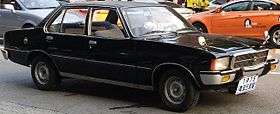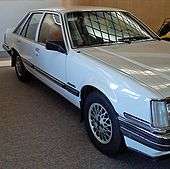Daewoo Royale
| Daewoo Royale | |
|---|---|
| Overview | |
| Manufacturer |
General Motors Korea (1975–1976) Saehan (1976–1983) Daewoo (1983–1993) |
| Production | 1972–1993 |
| Body and chassis | |
| Body style | 4-door sedan |
| Platform | GM V |
| Chronology | |
| Successor |
Daewoo Arcadia (replaced Imperial) Daewoo Prince (replaced Royale) |
The Daewoo Royale is a series of mid-size cars that was produced by Daewoo in South Korea from 1983, being replaced by the Daewoo Prince in 1991, although production of the top-line Daewoo Imperial continued until 1993. The Royale's predecessor was launched in 1972 by General Motors Korea (GMK) as the Rekord, becoming the Saehan Rekord in 1976 when Saehan Motors replaced GMK, until production ended in 1978. This car was a version of the German Opel Rekord D.
The second generation Saehan Rekord was a development of the Opel Rekord E. Production began in 1978, along with the Saehan Royale. The Royale was the Rekord E bodyshell with the front grafted on from the Opel Senator A. The Saehan Royale became the Daewoo Royale in 1983, with Saehan Rekord being discontinued and incorporated into the Royale lineup as the Daewoo Royale XQ. In 1989, the flagship Daewoo Imperial was introduced, based on the standard Royale. While Royale production ended in 1991, Imperials continued until 1993, being replaced by the Daewoo Arcadia.
First generation (1972–1978)
|
| |
|
|
| First generation | |
|---|---|
 1975 GM Korea Rekord Royale | |
| Overview | |
| Also called |
Rekord: Opel Rekord D Rekord Royale: Opel Commodore B |
| Production | 1972–1978 |
General Motors Korea (GMK) launched the Rekord in August 1972.[1] The GMK Rekord was based on the German-designed Opel Rekord D.[2] In August 1975, a version of the Rekord, known as the Rekord Royale was launched by GMK.[1] The Royale version was based on the Opel Commodore B, which was essentially the Opel Rekord with a lengthened engine bay.[3] 12,005 Royales were produced between 1975 and 1978.[2] In November 1976, GMK changed its name to Saehan Motors,[1] and as a result, the Rekord and Rekord Royale became the Saehan Rekord and Saehan Rekord Royale.
Second generation (1978–1993)
| Second generation | |
|---|---|
 | |
| Overview | |
| Also called | Daewoo Imperial |
| Production | 1978–1993 |
| Body and chassis | |
| Related |
Rekord: Opel Rekord E Royale (early): Holden Commodore (VB–VH) Opel Rekord E1/Senator A1 (Commodore C) Royale (mid): Opel Rekord E2/Senator A2 Royale (late): Opel Senator A2 |

The second generation Saehan Rekord was based on the Opel Rekord E. It was introduced in 1978 along with the Saehan Royale, which was essentially the Rekord E, featuring the front-end of the larger Senator A.
In January 1983, after Daewoo gained control, Saehan Motors changed its name to Daewoo Motors. At the same time the Saehan Royale was renamed Daewoo Royale,[4] and the Saehan Rekord was absorbed in the Royale range, becoming known as the Royale XQ.[5] Production of the XQ ended in 1987.[6]
Until November 1984, Royale body panels were stamped by Holden in Australia, where the Rekord-Senator hybrid was manufactured there as the Holden Commodore.[7] After November 1984, Daewoo began pressing their own panels on a newly installed production line.[7] The E1 bodystyle continued to be built as the Royale XQ and Diesel, while the Prince received the Senator A2's front end. All Korean-built shells, however, received a unique rear pressing with large, somewhat sloped rectangular taillights, which increased the length by about 5 cm (2 in).[8] The Royale Salon continued with the Senator A1 front end until it received a whole new front in 1987. The Royale Salon Super was introduced in 1986. However, unlike other Royales that utilised the Opel Rekord E2/Senator A2 hybrid with the four-window glasshouse design, the Salon Super used the six-window design from the Senator A.[9] A second design revision came in 1987 with a new front-end design, featuring a revised grille and headlamps, along with minor trim changes. While lower-specification versions such as the Royale Salon retained the four-window design, the Royale Super Salon continued using the six-window design from the now discontinued Salon Super.[10] The old-style XQ and Diesel received an all new front end of a smooth, upright, and rectangular appearance. 1989 marked another design change; the Royale Prince inherited a new grille insert and adopted the six-window glasshouse.[11] From 1989, Daewoo introduced the top-of-the-range Imperial, which was marketed separate from the Royale range.[12] Imperial production ended in 1993, replaced by the Daewoo Arcadia.[13]
Specification levels
|
| |
|
| |
|
| |
|
| |
|
| |
|
|
Daewoo Royale engines were four-cylinder Opel units,[14] with Daewoo offering the Royale in several different levels of luxury: the Diesel, Salon, Duke, XQ, and Prince:[15]
- Royale Diesel (May 1980[16]–April 1989): As the Royale Duke Diesel from early 1987; fitted with Opel's 2.0-liter diesel engine.
- Royale Salon (September 1980 – September 1991): fitted with a 1979 cc engine and three-speed automatic transmission. This powertrain combination produced 100 PS (74 kW) (DIN) and 156 N·m (115 ft·lb) (DIN). Top speed was claimed at 170 km/h (110 mph).[17]
- Royale Salon Super: (March 1986 – 1987):[16] this fully equipped model (digital dashboard, trip computer, EFI, etcetera) uses the Senator's six-window glass house.
- Royale Super Salon: (1987–1991):
- Royale Duke (February 1987 – March 1989): a new lower-end model fitted with a more modern 1498 cc engine.
- Royale XQ (August 1983 – 1987): fitted with a 1492 cc engine and four-speed manual transmission. This powertrain combination produced 44 kW (60 PS; 59 hp) (DIN) and 100 N·m (74 ft·lb) (DIN). Top speed was claimed at 135 km/h (84 mph).[18]
- Royale Prince (July 1983–June 1991): used the E2 bodywork, fitted with a 1897 cc engine and four-speed manual transmission. This powertrain combination produced 63 kW (86 PS; 84 hp) (DIN) and 142 N·m (105 ft·lb) (DIN). Top speed was claimed at 168 km/h (104 mph).[19]
- Daewoo Imperial (1989–1993): the Imperial was the ultimate development of the Royale, developed in response to the Hyundai Sonata and Grandeur. Imperial styling was reminiscent of the contemporary Chrysler Imperial and New Yorker, but also some Japanese luxury sedans. Its formal roofline, and much revised front- and rear-end styling helped to cover up the car's Opel Senator roots.[13] Imperial was specified with a vinyl roof, Bosch anti-lock brakes, digital instrumentation, cruise control, automatic climate control air conditioning, power windows, power door locks, power steering, a trip computer, and leather upholstery. A 2969 cc engine and four-speed automatic transmission was also fitted. This powertrain combination produced 116 kW (156 hp) and 153 N·m (113 ft·lb). Top speed was claimed at 195 km/h (121 mph).[20]
References
- 1 2 3 "1970~1979" (in Korean). Korea Automobile Manufacturers Association. Archived from the original on 29 November 2014.
- 1 2 КАДАКОВ, Максим. Между прошлым и будущим (in Russian). Газета АВТОРЕВЮ. Archived from the original on 26 October 2010. Retrieved 20 March 2008.
- ↑ Schaefers (1998–2008). The "1973 Rekord" is quoted to be 457 cm in length; the "1976 Rekord Royale" 462 cm. These two lengths correspond to those of the Opel Rekord D and Opel Commodore B, respectively.
- ↑ "Saehan (새한)" (in Korean). Samsung Transportation Museum. Archived from the original on 22 July 2012.
- ↑ "Daewoo (대우)" (in Korean). Samsung Transportation Museum. Archived from the original on 29 July 2012.
- ↑ "Saehan Rekord royale (새한 레코드 로얄)" (in Korean). Samsung Transportation Museum. Archived from the original on 26 October 2010. Retrieved 21 September 2009.
- 1 2 Robertson (1984), p. 32. "Currently, Commodore panels, pressed by GM-H, are used in the Daiwoo [sic] Royale. But that contract won't be repeated. While I was there they were installing a new line of presses that will, by November, be pressing the panels."
- ↑ Schaefers (1998–2008).
- ↑ Schaefers (1998–2008).
- 1986 Daewoo Royale: Salon Super
- ↑ Schaefers (1998–2008).
- 1987 Daewoo Royale: Salon, Super Salon
- ↑ "1989 Daewoo Imperial (television commercial)" (in Korean). Daewoo Motors. 1989. Retrieved 10 September 2009.
- ↑ "1989 Daewoo Royale Prince (television commercial)" (in Korean). Daewoo Motors. 1989. Retrieved 21 September 2009.
- 1 2 "Daewoo Imperial". Autocade. JY&A Media. Archived from the original on 26 October 2010. Retrieved 17 October 2009.
- ↑ Robertson (1984), p. 31. "...a car called the Royal [sic] made by Daiwoo [sic] using Holden Commodore body panels shipped from Melbourne and Opel 1.9- and 2.0-litre four-cylinder engines..."
- ↑ Aspee, Diego. "Daewoo's 60' 70' y 80'" (in Spanish). Archived from the original on 26 October 2010. Retrieved 20 March 2008.
- 1 2 "1980~1989" (in Korean). Korea Automobile Manufacturers Association. Archived from the original on 29 November 2014.
- ↑ "1985 Daewoo Royale Salon". Carfolio.com. Archived from the original on 26 October 2010. Retrieved 20 March 2008.
- ↑ "1985 Daewoo Royale XQ". Carfolio.com. Archived from the original on 26 October 2010. Retrieved 20 March 2008.
- ↑ "1985 Daewoo Royale Prince". Carfolio.com. Archived from the original on 26 October 2010. Retrieved 20 March 2008.
- ↑ "대우자동차 임페리얼 DAEWOO Imperial - 국산 첫 3000CC 엔진, ABS를 장착한 고급차". 국산 자동차 이것저것 (in Korean). 27 August 2007. Archived from the original on 26 October 2010. Retrieved 20 September 2009.
Bibliography
| Wikimedia Commons has media related to Daewoo Royale. |
- Robertson, David (September 1984). "A new contender". Modern Motor. Sydney, New South Wales: Australian Consolidated Press.
- Schaefers, Martin (1998–2008). "Rekord body history". Far East Auto Literature. Retrieved 21 September 2009.
| Daewoo Motors and GM Daewoo automobile timeline, 1980s–2011 | ||||||||||||||||||||||||||||||||
|---|---|---|---|---|---|---|---|---|---|---|---|---|---|---|---|---|---|---|---|---|---|---|---|---|---|---|---|---|---|---|---|---|
| Type | 1980s | 1990s | 2000s | 2010s | ||||||||||||||||||||||||||||
| 0 | 1 | 2 | 3 | 4 | 5 | 6 | 7 | 8 | 9 | 0 | 1 | 2 | 3 | 4 | 5 | 6 | 7 | 8 | 9 | 0 | 1 | 2 | 3 | 4 | 5 | 6 | 7 | 8 | 9 | 0 | 1 | |
| City car | Tico | Matiz | Matiz Creative | |||||||||||||||||||||||||||||
| Subcompact | Lanos | Kalos | Gentra | |||||||||||||||||||||||||||||
| Compact | Maepsy-Na | LeMans | Cielo | Nubira | Lacetti | Lacetti Premiere | ||||||||||||||||||||||||||
| Mid-size | Espero | Leganza | ||||||||||||||||||||||||||||||
| Royale Series | Prince & Brougham | Polonez Kombi | ||||||||||||||||||||||||||||||
| Imperial | Arcadia | Magnus | Tosca | |||||||||||||||||||||||||||||
| Full-size | Chairman | Statesman | Veritas | |||||||||||||||||||||||||||||
| Roadster | G2X | |||||||||||||||||||||||||||||||
| Microvan | Damas & Labo | |||||||||||||||||||||||||||||||
| Compact MPV | Tacuma | |||||||||||||||||||||||||||||||
| Mini SUV | Korando | |||||||||||||||||||||||||||||||
| Compact SUV | Honker | Winstorm MaXX | ||||||||||||||||||||||||||||||
| Mid-size SUV | Musso | Winstorm | ||||||||||||||||||||||||||||||
| Van | Istana | |||||||||||||||||||||||||||||||
| Lublin | ||||||||||||||||||||||||||||||||